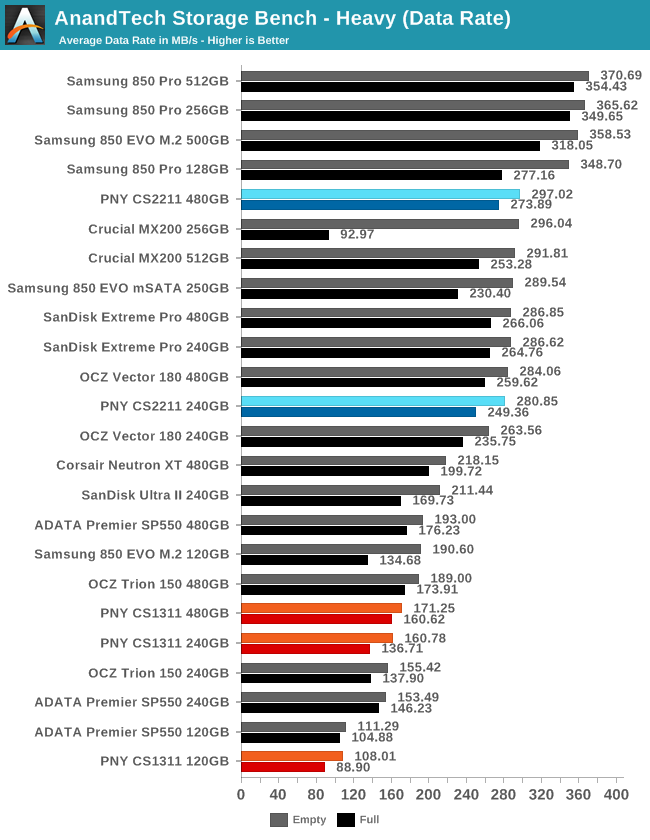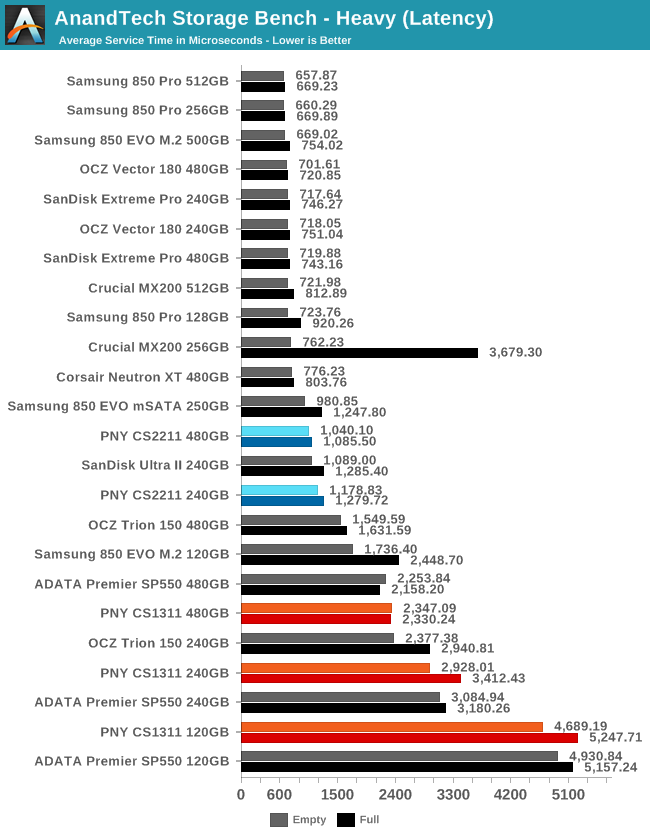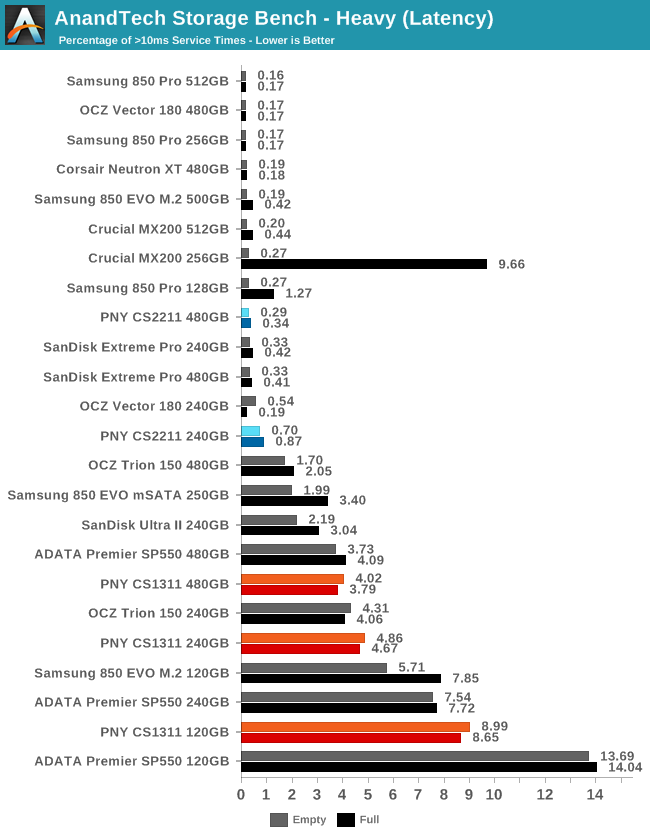The PNY CS1311 and CS2211 SSD Review: MLC vs TLC at 15nm
by Billy Tallis on April 15, 2016 8:00 AM ESTAnandTech Storage Bench - Heavy
Our Heavy storage benchmark is proportionally more write-heavy than The Destroyer, but much shorter overall. The total writes in the Heavy test aren't enough to fill the drive, so performance never drops down to steady state. This test is far more representative of a power user's day to day usage, and is heavily influenced by the drive's peak performance. The Heavy workload test details can be found here.

The CS2211 drives both perform well overall and are bracketing a tight cluster of drives that perform similarly, though some of the competitors don't handle a full drive as well as the CS2211 does. The 240GB CS1311 is roughly tied with its competition while the other two capacities are clearly behind, though not by an embarrassing margin. On such a write-heavy test, it's no big surprise to see the MLC drives running 70% faster than the equivalent planar TLC drive.

Average service time isn't a strength of either PNY model. The CS2211 is the slowest MLC drive in this bunch, and the CS1311 is the slowest of the lot when full. At 480GB the OCZ Trion 150 retains a clear lead over the other planar TLC drives.

The latency outliers above 10ms put the CS2211 in a favorable light while the CS1311 mostly performs better than the ADATA SP550 but worse than the Trion 150. The huge gap between PNY's MLC and TLC models shows how a write-heavy workload can burn through a drive's pseudo-SLC cache and make TLC's weaknesses felt.

The CS1311's power efficiency is worse than almost everything else, but not horrendously so. The CS2211 is about average. The gap beterrn the 15/16nm TLC drives and the rest of the field is small but clear.










43 Comments
View All Comments
futrtrubl - Saturday, April 16, 2016 - link
How is that not good enough? That's 3 years if you rewrite the ENTIRE drive EVERY DAY.Let's pick a long 9 year planned lifetime for a drive as you would probably want to upgrade by then for non-failure reasons. That means you could write 1/3 of the drive's capacity every day for those nine days. For a 256GB drive (somewhat on the small end now) that's 85GB every day. Or installing 2-3 AAA games every day!
bug77 - Sunday, April 17, 2016 - link
Well, on a modern OS you no longer control the amount of data being written. Automatic updates, indexing, metadata, restore points... the OS will write those whenever it wants to.If planar TLC was half the cost of MLC or V-NAND TLC, I may consider it. But since it's within 10-20%, I'd rather get the better drive.
doggface - Tuesday, April 19, 2016 - link
The average laptop user writes 10-20gb a day. Even if you were double average you would still be safe as houses.BrokenCrayons - Thursday, April 21, 2016 - link
I have a modern OS on my laptop and have quite a bit of control over what does or doesn't get written to storage. For instance, there are no restore points, indexing is mine to manage as I see fit. I can pick when and what I want to update, and I haven't allocated a partition to swap (thank you Linux). You just have to exercise a bit of selectivity about which modern OS you decide to install.rarson - Monday, April 18, 2016 - link
In my experience, the average mechanical hard drive has a life of about 2 years. I see many of them fail before then, and most of the drives these that last over 5 years are already 8+ years old.I recently bought one of Seagate's 8TB archival drives and it started making some clicking noises right out of the box. It hasn't given me any problems yet, but it is a bit disconcerting to hear a click every couple minutes. Hard drives just don't last very long anymore, while my SSDs have been rock solid with everyday use. I would not install my operating system on a mechanical drive ever again. No reason to do so.
fire400 - Monday, May 23, 2016 - link
i put windows XP on this 1311, and it's the fastest I've ever seen XP do anything, startup, tasks, and installing software and launching programs, faster than high end workstation systems on HDD's, since it's debut in 2001... loland yes, the XP OS is extremely stable because the 1311 takes care of garbage collection in the background.
burn tested it for several hours and days on end, it's perfect...
LB-ID - Friday, April 15, 2016 - link
I can't imagine buying any PNY products in any event, but even more so given that the Samsung EVO is so much more bang and reliability for your buck.DigitalFreak - Friday, April 15, 2016 - link
Every PNY device I've had, whether SD cards or video cards, has died prematurely. Absolute garbage.The_Assimilator - Friday, April 15, 2016 - link
That's what the "XLR8" part stands for!TheinsanegamerN - Wednesday, April 20, 2016 - link
My pny 770s are going strong 2.5 years later. Also some of the coolest running 770s I've seen